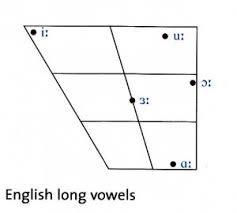Phonetics
3. Vowels
3.3. Long Vowels

The five long vowels are different from the six short vowels described in Chapter 7, not only in length but also in quality. If we compare some similar pairs of long and short vowels, for example a with a:, or i with i: we can see distinct differences in quality (resulting from differences in tongue shape and position, and lip position) as well as in length. For this reason, all the long vowels have symbols which are different from those of short vowels; you can see that the long and short vowel symbols would still all be different from each other even if we omitted the length mark, so it is important to remember that the length mark is used not because it is essential but because it helps learners to remember the length difference.
i: (example words: 'beat', 'mean', 'peace') This vowel is nearer to cardinal vowel no. 1 [i] (i.e. it is closer and more front) than is the short vowel of 'bid', 'pin', 'fish' described in Chapter 7. Although the tongue shape is not much different from cardinal vowel no. 1, the lips are only slightly spread and this results in a rather different vowel quality.
3: (example words: 'bird', 'fern', 'purse') This is a mid-central vowel which is used in most English accents as a hesitation sound (written 'er'), but which many learners find difficult to copy. The lip position is neutral.
a: (example words: 'card', 'half, 'pass') This is an open vowel in the region of cardinal vowel no. 5 [a], but not as back as this. The lip position is neutral.
: (example words: 'board', 'torn', 'horse') The tongue height for this vowel is between cardinal vowel no. 6 [c] and no. 7 [o], and closer to the latter. This vowel is almost fully back and has quite strong lip-rounding.
U: (example words: 'food', 'soon', 'loose') The nearest cardinal vowel to this is no. 8 [u], but BBC u: is much less back and less close, while the lips are only moderately rounded.